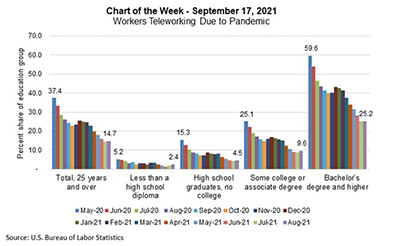
MBA Chart of the Week Sept. 17 2021–Teleworking Due to Pandemic

The COVID-19 pandemic has forced many businesses to change the way they operate, and even 18 months later, there are different views and strategies for the workplace, with teleworking at the center of many discussions.
This week’s MBA Chart of the Week examines supplemental data from the U.S. Bureau of Labor Statistics on teleworking. These are based on a monthly survey that includes asking whether people teleworked or worked from home because of the pandemic within the last four weeks.
In May 2020, an estimated 37.4% of workers ages 25-years and older teleworked because of the pandemic. The share dropped to 14.7% as of August 2021. However, there were very different results when the sample was split by education. For example, 15.3% of workers with a high school diploma teleworked at the beginning of the pandemic; the share dipped to 4.5% in August.
In contrast, 59.6% of workers with a bachelor’s degree or higher worked remotely in May 2020, and 25.2% of those workers still teleworked in August. Workers with a bachelor’s or higher accounted for 43.6% of the workforce in August but 74.8% of all workers who teleworked for pandemic-related reasons, while workers with a high school diploma made up 25% of the workforce, and only accounted for 7.7% of teleworking workers.
These trends have many different implications for our economy and housing markets. One such result was that higher educated workers who are more likely to telework have contributed to the boom in housing demand. With commuting less of a factor in their buyer preferences, demand has increased in more suburban areas or even in different states, pushing home-price appreciation to record levels in many areas. However, workers in the educational groups with fewer opportunities to telework have not had such options. These workers are also more susceptible to employment interruptions if the public health situation worsens to the point of closures again.
- Mike Fratantoni (mfratantoni@mba.org), Joel Kan (jkan@mba.org)
